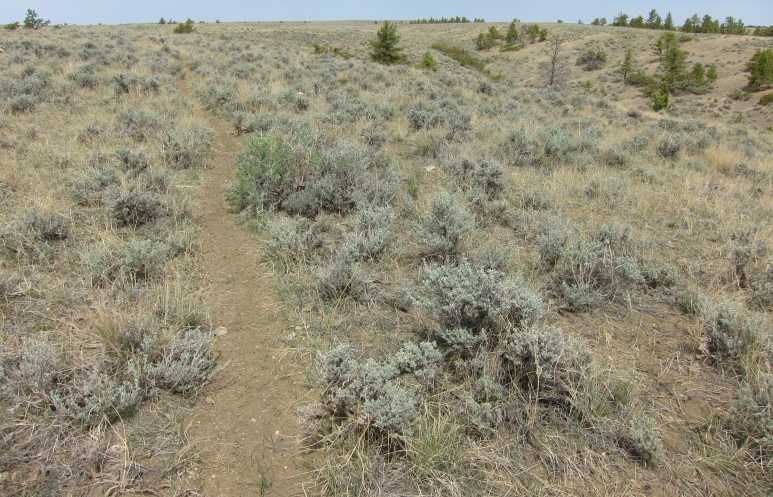I took my own advice this weekend, sucked it up, didn’t go to the Bob, and instead made the long drive to somewhere totally unfamiliar: The Missouri River Breaks National Monument.
It was good to be hiking in cactus country again.
Befitting the desert, water was a problem on my route. The idea was to hike upstream, cutting a ninety degree bend across the badlands, then packraft back the next day.
All the water I found looked like below, or worse, and was salty enough to be undrinkable.
There was that cattle tank, but the shit to water ratio was well over my cutoff.
The elk/antelope/deer/cow trails were awesome. Above looking SE, below looking NW.
By early afternoon I was, after a lot of up and down, up at the height of land, with drainages leading either south the way I had come, but north and then west where I had hoped to go. I did not have much water left. It was pushing 90 degrees, and the breeze had died. The gulch heading south was a bit shorter on the map, so I played it safe and dropped in.
The tight, twisting canyon reminded me of the Markagunt around Bryce, or the circa 7k reaches above Zion.
Sure enough I ran out of water, with no useable sources and many miles to go. No point in doing anything else but keep moving as the cottonmouth grew.
Cow traffic in the area was minimal, and several months old. Or older.
I was suffering a fair bit, but the scenery kept me going. I like the desert, I like XC hiking, and I like seeing new stuff around every corner.
The river was still a really welcome sight. Fortunately I had brought some Carborocket, which helped bring me back to life once the Aquamira kicked in. It also gave me enough wherewithall to check for ticks and find seven on my left leg (but none on my right), which was pretty icky.
At that point I had a few hours of daylight left, and a lot fewer river miles to get back to the car. Fortunately the Missouri is really slow. Also fortunately, it was amazingly quiet, all the better to enjoy the massive amount of wildlife. The loud splashes following ahead of me turned out to be Spiny Softshell turtles hucking themselves off the bank. The number of bank beaver lodges was astonishing, and around dusk the beavers came out in force, and sitting up on the bank watching them cruise back and forth was fantastic. I did sleep on my raft in the vain hope that it would keep the ticks away. (I pulled one off in the morning.)
The morning of the second day I was still cooked, tasty and big dinner nonwithstanding. More packrafting in the cool early morning was perfect, especially as the Missouri is, unlike all our local rivers, mellow enough to zone and not worry about being swept into a snag. Hours later I was back near the road and subject to the slack jawed wonder of fisherpeople at my Scout and I, one of whom even helpfully told me FWP would give me an 80 dollar ticket for not having a PFD. I packed up, and started the long drive home, content.
Chris Townsend wrote about wilderness recently, concluding that “The distance doesn’t matter; it’s the situation that says where you are.” There is big dubya Wilderness in the US which in season have tons of people. The “most remote place” in the lower 48 is in August a 6-8 hour hike along trails wide enough for ATV traffic. There are, at the same time, lots of places which are not denoted by a big green spot on the atlas and like the Breaks have lots of roads. These roads may be driven once a year. They feel pretty wild. I’d refine Mr. Townsend’s statement to say that miles don’t matter, but effective distance from other humans makes all the difference.
The best thing is that there are a lot more of these wild places than you think, hiding in plain sight.













Leave a comment